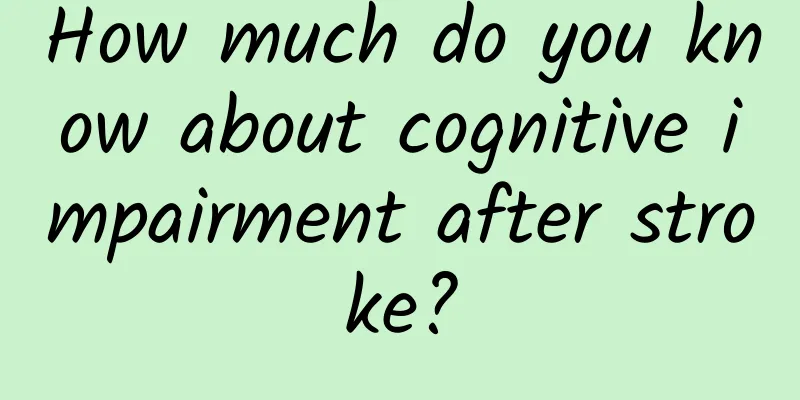How much do you know about cognitive impairment after stroke?

|
Stroke is a disease with high morbidity, disability and mortality. Globally, my country has become the country with the highest lifetime risk of stroke and the heaviest disease burden. Among them, about 1/3-1/2 of stroke patients will experience post-stroke cognitive impairment. Once post-stroke cognitive impairment occurs, the patient's mortality rate increases significantly, and the 5-year survival rate is only 39%, while the survival rate of stroke patients of the same age without dementia is 75%. Therefore, after a stroke, we should pay attention not only to limb paralysis and swallowing problems, but also to cognitive impairment, emotional disorders and mental problems. What is post-stroke cognitive impairment? Post-stroke cognitive impairment refers to a clinical syndrome characterized by cognitive impairment that occurs after a stroke event and persists up to 6 months. What are the symptoms of cognitive impairment after stroke? The human brain has two hemispheres, five lobes, and numerous nerve fiber networks, each of which performs its own function. Therefore, the clinical manifestations of post-stroke cognitive impairment are closely related to the location and size of brain lesions, as well as the presence of potential senile dementia, age, and education level. Currently, there are four main clinical manifestations of post-stroke cognitive impairment: 1. Decreased executive function and attention Some patients suffer from a stroke and experience reduced planning, design and anti-interference abilities at work, as well as difficulty concentrating. for example: ◆In daily life, we seem to be at a loss as to what to do when it comes to cooking and how to entertain guests. ◆Some emotional disorders, irritability, negative emotions and indifference occur. 2. Memory loss There are parts and circuits related to memory in the brain, such as the hippocampus, thalamus, cerebral cortex and its connecting fibers. Once the memory circuit is damaged, memory disorders will occur. for example: I forget what I just learned a while after eating. When I ask a question repeatedly, sometimes I can be reminded, but sometimes I can't remember it at all. I even lose long-term memory. 3. Language dysfunction Symptoms of a stroke that affect language are easily identified, including: ◆Motor aphasia: can understand other people's language but cannot express it; ◆Sensory aphasia: Unable to understand other people's language, can have spontaneous language, but can't understand what they are trying to express; ◆Anonomic aphasia: Unable to correctly name familiar people and objects, but can know the purpose of objects. 4. Visual-spatial impairment Refers to the space in human vision. Visual-spatial perception function, visual-spatial working memory, visual-spatial structural ability, etc. for example: Some patients after cerebral infarction find that they cannot recognize the faces of their loved ones, cannot play games with building blocks, cannot complete the clock drawing test, etc. Therefore, it is important to observe and detect the above symptoms in an acute stroke, especially if there are changes compared to the patient's pre-illness condition. Doctors will use various assessment scales for quantitative assessment. How is post-stroke cognitive impairment diagnosed? There should be three elements: 1. A clear stroke diagnosis: a stroke diagnosis supported by clinical or imaging evidence, including transient ischemic attack, hemorrhagic stroke, and ischemic stroke. 2. Presence of cognitive impairment: Patient complaints, reports from informed sources, or judgment by experienced clinicians indicate cognitive impairment after a stroke event, and neuropsychological evidence confirms the presence of functional impairment in one or more cognitive domains or evidence of cognitive decline compared to the past. 3. The temporal relationship between stroke and cognitive impairment: it occurs after the stroke event and lasts for 3 to 6 months. Who is prone to post-stroke cognitive impairment? 1. Elderly, female, or low-educated patients. 2. Patients with a history of stroke or recurrent stroke, hemorrhagic stroke, multiple lesions, large lesions, or dominant hemisphere lesions. 3. Imaging findings include atrophy of the entire brain or medial temporal lobe and white matter lesions. 4. A history of hypertension, diabetes, atrial fibrillation, smoking, or cognitive impairment before stroke. 5. People with stroke complications, such as infection, delirium, epileptic seizures, etc. How to treat cognitive impairment after stroke? 1. Treatment of stroke (thrombolysis, antiplatelet, anticoagulation, lipid regulation, etc.). 2. Treatment of stroke complications (cerebral edema, epilepsy, lung infection, gastrointestinal bleeding, electrolyte imbalance, etc.). 3. Treatment of cognitive dysfunction. ◆Drug treatment: There is limited research on drug treatment of post-stroke cognitive impairment. Currently, the cholinesterase inhibitors donepezil and rivastigmine are recommended for improving patients' cognitive function and daily living ability. Memantine has good safety and tolerability and may be effective for post-stroke aphasia. Mannitol sodium can improve cognitive function in mild to moderate Alzheimer's disease and may be beneficial in patients with post-stroke cognitive impairment. Butylphthalide, Ginkgo biloba extract, nicergoline, nimodipine, citicoline, and pentoxifylline may improve cognitive function in patients with post-stroke cognitive impairment. If emotional disorders such as anxiety and depression occur, or mental and behavioral abnormalities such as hallucinations, delusions, and aggressive behavior occur, anti-mental disorder and anti-anxiety and depression treatments are required. Non-drug treatment: Including psychological intervention, cognitive training (covering task training of increasing difficulty in processing speed, attention, perception, long-term memory, working memory, calculation, execution, reasoning and problem solving. Aerobic exercise, acupuncture, transcranial magnetic stimulation and transcranial direct current stimulation, etc.). |
<<: Food Safety | Will eating too many oranges cause internal heat? Five truths about eating oranges
>>: Hitwise: More than 50% of adult Internet users in the United States regularly use Facebook
Recommend
How much bird's nest is suitable for pregnant women
Bird's nest is a very good nourishing health ...
How to reduce the trapezius muscle of the shoulder for girls
In fact, people are often troubled by the issue o...
Will the temperature rise during menstruation?
If menstruation is regarded as the starting point...
What to do if a pregnant woman has uterine contractions during an erotic dream
During pregnancy, pregnant women will have a stro...
What is the cause of delayed menstruation and black blood clots?
Menstruation generally has a normal cycle, usuall...
New research finds that milk tea is addictive and may increase the risk of depression and anxiety
In recent years, the popularity of milk tea in Ch...
What is the reason for infrequent menstruation after childbirth?
For women, conceiving a life is an extremely impo...
What are the details of sea buckthorn juice? What does sea buckthorn juice taste like?
Seabuckthorn juice is rich in vitamin C and vitam...
What causes less armpit hair during pregnancy?
Everyone has armpit hair, but some people have mo...
When is the best time for a woman to get pregnant?
I believe that for a loving couple, being able to...
The process of induced abortion at 5 months of pregnancy
When you are five months pregnant, the month is a...
Can pelvic inflammatory disease be detected by ultrasound?
Pelvic inflammatory disease is a common gynecolog...
Is radiation in daily life harmful to the human body?
Radiation is always a concern. But in fact, it is...
The pathogenic bacteria that aggravate intestinal cancer actually come from the mouth? !
More and more cancers are found to be related to ...
What nuts should pregnant women eat to improve the fetal brain development?
Dried fruits are fruits with shells on the outsid...









